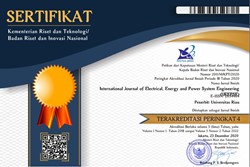Case Service System at the Child Welfare Institution using the Case-Based Reasoning Method
Abstract
The Child Social Welfare Institution (LKSA) is an institution tasked with providing relief services to meet the standards of living, health, education, and the social needs of both individuals and groups. An LKSA Robbani is one of the institutions that help in handling family and child cases by National Standards for Child Care. In solving child problems, the institution must open the previous case data to determine the appropriate solution, such that the service process becomes long. Therefore, an application software is needed that can help the institution to be faster. The developed system is using the Case-Based Reasoning (CBR) Method. The advantage of this method is how to adapt the solutions of the previous case, as well as in seeking similarity in each case that the most significant similarity value is considered the most similar case. The method is very suitable for building the application. The system that was built had to do a trial before being used by the user. The trial result was carried out of the system with manual calculations using the case-based reasoning method. Furthermore, from the results of the trial, it was produced by 87.5%.
References
[1] UU-11, KesejahteraanSosial, 2009.
[2] Salamun, “Penerapan Algoritma Nearest Neighbour dan CBR pada Expert System Penyimpangan Perilaku Seksual”, JOIN J. Online Inform., vol. 2, no. 2, pp. 63–70, Desember 2017.
[3] L. Verma, S. Srinivasan, and V. Sapra, “Integration of Rule-based and Case-Based Reasoning System to Support Decision Making”, IEEE, p. 3, 2014.
[4] E. T. Luthfi, “Penerapan Case Based Reasoning Dalam Mendukung Penyelesaian Kasus”, STMIK AMIKOM Yogyakarta, 2017.
[5] I. Purwandani, “Penerapan Case Based Reasoning Dan Nearest Neighbour Retrieval Untuk Diagnosa Penyakit Langganan Anak”, J. Speed Sentra Penelit. Eng. Dan Edukasi, vol. 9, no. 2, pp. 1–7, 2017.
[6] Pengertian dan Fungsi PHP dalam Pemrograman Web Duniailkom. [Online]. Available: https://www.duniailkom.com/pengertian-dan-fungsi-phpdalam-pemograman-web/ [Accessed: 16-Jun-2019].
[7] Profil Lembaga Kesejahteraan Sosial Robbani, LKSA ROBBANI, 2010.
[8] Studi Kasus / Problem Solving. Lembaga Kesejahteraan Sosial Anak Robbani, 01-Sep-2014.
[9] Y. A. Gerhana, H. . Sudanyana, and T. Budiman, “Case Based Reasoning (CBR) dan Pengembangan Kemampuan Penyelesaian Masalah”, UIN Sunan Gunung Djati Bdg., vol. 2, p. 16, Jul. 2013.
[10] R. Hardianto, “Sistem Pakar Penentuan Tipe Kepribadian Siswa Sekolah Dasar Menggunakan Metode Case Base Reasoning”, J. Inf. Technol. Comput. Sci. INTECOMS, vol. 1, no. 2 Desember 2018, p. 11, 2015.
[11] M. Shaid, W. L. YS, and Y. R. Utami, “Sistem Pakar Pertumbuhan Balita Berbasis Web Dengan Metode case Base Reasoning”, J. TIKomSiN, p. 8. 2017.
[12] A. A. Fahmi, “Rancang Bangun Aplikasi Untuk Pemecahan Masalah Mahasiswa Menggunakan Metode Case Based Reasoning Dengan Pendekatan Psikologi Positif”, Universitas Islam Negeri Maulana Malik Ibrahim, Malang, 2014.
[13] S. Hendra and S. Kusumadewi, “Perancangan Aplikasi Konseling Mahasiswa Menggunakan Metode Case Based Reasoning”, p. 8. 2016,
[14] U. Saripudin, Y. A. Gerhana, and C. Slamet, “Pengaruh Case-Base Reasoning (CBR) Terhadap Kemampuan Pemecahan Masalah Siswa (Penerapan Pada Pembelajaran Bahasa Indonesia)”, UIN Sunan Gunung Djati Bdg., vol. IX, p. 25. 2015.
[15] R. Retnowati and A. Pujiyanta, “Implementasi Case Base Reasoning Pada Sistem Pakar Dalam Menentukan Jenis Gangguan Kejiwaan”, J. Sarj. Tek. Inform., vol. 1, p. 10, Jun. 2013.



















